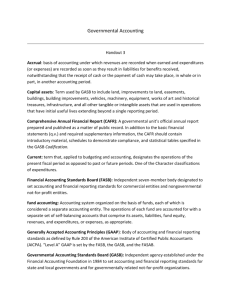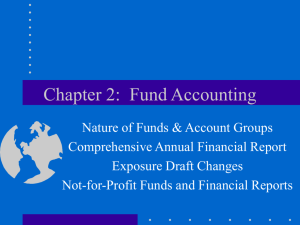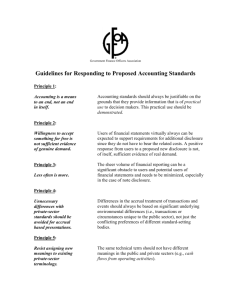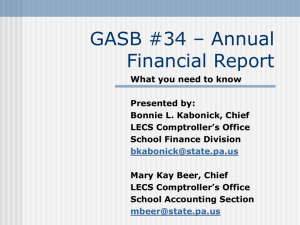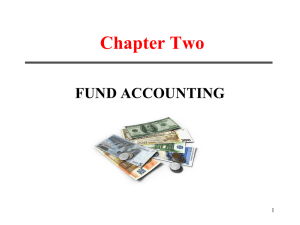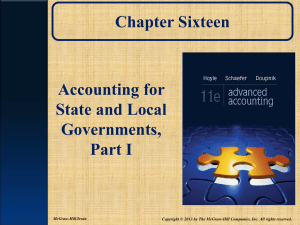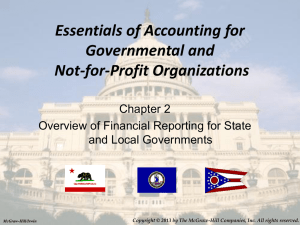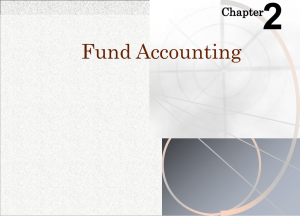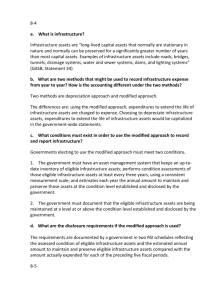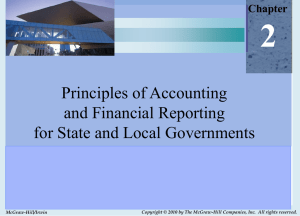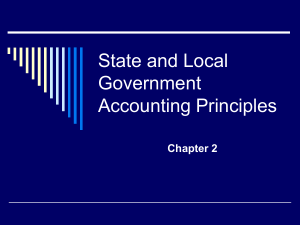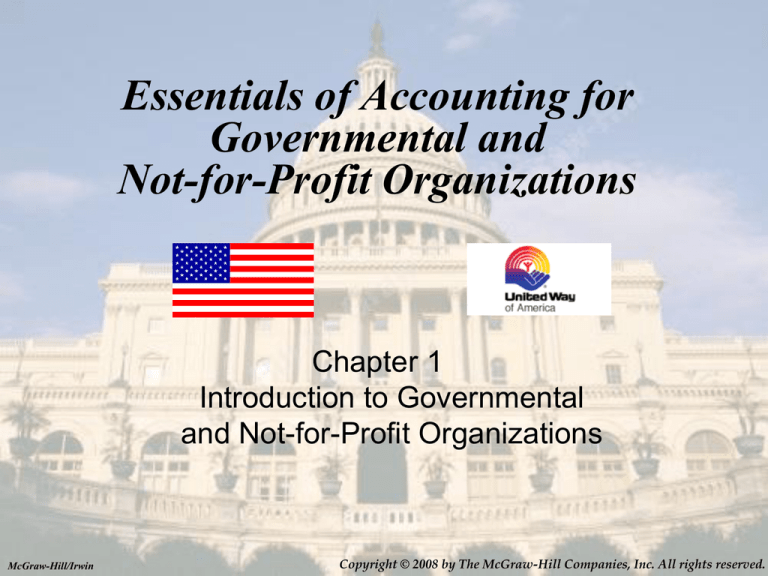
Essentials of Accounting for
Governmental and
Not-for-Profit Organizations
Chapter 1
Introduction to Governmental
and Not-for-Profit Organizations
McGraw-Hill/Irwin
Copyright © 2008 by The McGraw-Hill Companies, Inc. All rights reserved.
Overview of Chapter 1
Why study GNP accounting
Differences in the environment that cause
GNP accounting to differ from business
accounting
GNP accounting standard setters
Major sections of the state and local
government (SLG) financial statements
Fund Types
1-2
Why Study GNP Accounting?
Governments and NFP organizations hire
accountants
CPA firms and states engage accountants
to perform their audits
As citizens and donors we wish to better
understand how taxes and charitable
donations are used
1-3
Differences in the GNP Environment
Organizational Purposes: Governments
exist for the well being of citizens by
providing public services – whether or not
the services are profitable undertakings.
Sources of Revenues: Governments
derive many of their resources from taxes.
1-4
Differences in the GNP Environment
Potential for Longevity: Governments very rarely go outof-business. This long term view of operations changes the
focus of accounting to a longer-term focus on the
sustainability of services and the ability to meet future
demand.
Relationship with Stakeholders: Governments have an
obligation to demonstrate accountability for these public
funds.
Role of the Budget: Government budgets often carry the
authority of law, preventing public officials from spending
outside their budgetary authority.
1-5
How Accounting Must Adapt to GNP
Environmental Differences
Traditional view of the equity accounts must be
modified
Budget compliance may be more important than
income measurement
When do we recognize revenue for nonexchange transactions
Reports must reflect the existence of restrictions
on the use of certain resources
Non-financial performance measures are
relatively more important
1-6
U.S. STANDARD SETTERS
Federal level
State and Local Government (SLG)
FASAB - Federal Accounting Standards Advisory
Board
GAO – Governmental Accountability Office
U.S. Treasury Department
OMB - Office of Management and Budget
GASB - Governmental Accounting Standards Board
Not-for-profits
FASB - Financial Accounting Standards Board
1-7
STANDARD SETTERS cont’d
State and Local - GASB formed in 1984
Covers basic governments and entities owned or
controlled by governments
Predecessor: NCGA - National Council on Governmental
Accounting
Not-for-profits - FASB formed in 1973
Covers not-for-profits not related to government entities
— private nonprofit hospitals, colleges, museums, etc.
Predecessors:
Accounting Principles Board (1959-1973) and
Committee on Accounting Procedures (1939-1959)
1-8
Authoritative Literature
Statements, Interpretations, and Technical
Bulletins are primary literature that specifies
GAAP (generally accepted accounting principles)
However, in absence of adequate guidance,
auditors may look at other documents
GAAP hierarchy (Illustration 1-2) guides the
auditor in the priority of importance for accounting
guidance
1-9
Concepts Statements
Concepts project began in the 1970s to guide the
standard setters in establishing GAAP
Not originally intended as authoritative GAAP.
Concepts statements may be used for guidance only if
no other literature addresses an issue
Though not intended as GAAP, concepts statements
drive the theory of GNP reporting and therefore may
appear on certification exams
1-10
FASAB Objectives for Federal
Financial Reports
Budgetary Integrity — demonstrate budget
regulations were adhered to
Operating performance — help evaluate
service, efforts, and accomplishments
Stewardship — show the impact on operations
and investments
Systems and controls — indicate whether they
are adequate
1-11
FASB Concepts Statement
No. 6 for NFPs
Main Objective of NFP Financial Statements is
To provide information useful to present and
potential resources providers and others in
making decisions about allocating resources to
the NFP organization
Which emphasizes that
Donors, government grantors and banks are
primary users
1-12
GASB Concepts Statements
GASB Concept Statement #1
Citizens have a right to know why resources
are being raised and how they will be used
GASB #1 Objectives of Financial Statements:
o
o
o
o
Allow comparison of actual with budgeted results
Help users assess financial condition and results
of operations
Show compliance with laws, rules and regulations
Assist in evaluating efficiency and effectiveness
1-13
Concept Statement #2
Service Efforts and Accomplishments
Reporting (covered in Chapter 13)
Includes both Financial and Nonfinancial
measures of performance
1-14
Concept Statement #3
Communication Methods in General
Purpose Financial Reports that Contain
Basic Financial Statements
Established the framework for what
information is presented in:
Basic Financial Statements
Notes
Required Supplementary Information
Supplementary Information
1-15
How Do GASB’s Objectives Differ
from Business Objectives?
There is more emphasis on
The budget
Legal compliance
Efficiency and effectiveness measures other
than net income
GASB Concepts Statement No. 2 explains that
nonfinancial measures (i.e. measures other than
dollars) are required to assess effectiveness.
1-16
Overview of Basic
Financial Statements
Government-wide Statements
Statement of Net Assets
Statement of Activities
Similar to business balance sheet
Similar to business income statement
Fund Financial Statements
Detailed reports of governmental, proprietary,
and fiduciary activities
Illustrated in the Chapter 2
1-17
Overview of Fund Financial Statements
Governmental — general citizen services
Proprietary — business-like activities such as water
utility
Balance Sheet
Statement of Revenues, Expenditures, and Changes in Fund
Balance
Statement of Net Assets (Balance Sheet)
Statement of Revenues, Expenses, and Changes in Fund Net
Assets
Statement of Cash Flows
Fiduciary — holding money in trust for others
Statement of Fiduciary Net Assets (Balance Sheet)
Statement of Changes in Fiduciary Net Assets
1-18
Reporting Perspectives
The government-wide reports are a relatively
new phenomenon in state and local government
reporting
Historically, state and local government reports
have emphasized only the fund activities
Internal accounting still tends to emphasize
individual funds (pools of money)
Government-wide reports are an attempt to
aggregate data into a format more familiar to
users — business-type financial statements
1-19
Accrual and Modified
Accrual Basis
Accrual Basis/Economic Resources
Measurement Focus:
General business concepts of revenue and
“expense” apply when recording exchange-like
transactions
Modified Accrual Basis/Current Financial
Resources Measurement Focus:
Applies to funds financed by taxes and other
involuntary contributions
1-20
Modified Accrual Basis
Revenues are recorded when “measurable
and available”
For example, property taxes revenues are
recorded as revenues if levied this year and
collected this year, or soon enough after the
year end to still pay current year bills
Outflows are called “expenditures”
Expenditures are recorded when the fund
liability is incurred
1-21
Implications for Revenues Under
Modified Accrual Basis
In the absence of an earning process,
revenue recognition is more of a
problem. GASB and FASB Statements
specifically address recognition of nonexchange and contribution revenues
1-22
Expenses vs Expenditures
Expenses under accrual basis recognize
the resources used
Supplies are treated as an expense when
used
Depreciation expense on fixed assets is
recognized over the life of the asset
1-23
Expenses vs Expenditures
Expenditures under modified accrual are
recorded when the liability is incurred
Supplies are treated as an expenditure when
purchased
Equipment purchases are treated as
expenditures as soon as you are obligated to
pay — when the goods arrive
Payments of principal on long-term debt are
treated as an expenditure
1-24
More Implications
of Modified Accrual
Issuance of bonds is treated as a
Financing Source, inflow on activity
statement
Long term debt is not listed on the fund
Balance Sheet
Long-term assets, such as equipment, are
not listed on the fund balance sheet
1-25
Fund vs. Government-Wide
Statements
Government-wide statements use
accrual basis and report long-term
assets and liabilities for both
governmental and business activities
Fund perspective statements use
modified accrual for governmental type
funds and omit long-term assets and
long-term liabilities on government fund
balance sheet
1-26
Fund and Government-Wide
Reporting
Two perspectives allow users to see
Long run — accrual basis effects
Short run — budget oriented “current
spending” effects:
1-27
What is a “fund” as the term is used for
state and local government accounting?
A fund
Represents a part of the activities of some organization
Is an accounting entity
Self-balancing set of accounts, reflecting the
assets, liabilities, net assets, and changes in those
balances
Segregates resources for specific activities
In such a way as to ensure compliance with
appropriate regulations or restrictions
1-28
Government Fund Types
Governmental type
Proprietary type
Used for activities that are largely unique to the
government environment
Business-type activities
Fiduciary type
Acting as an agent or trustee of moneys that
generally belong to other parties
1-29
Five Governmental-Type Funds
PERMANENT FUND - report financial resources
that are legally restricted so only earnings, not
principal, may be expended, for purposes to benefit
the government and its citizenry.
CAPITAL PROJECTS FUND - Is used to account
for the financial resources available and used for
acquisition or construction of fixed assets other than
that associated with enterprise or fiduciary funds.
DEBT SERVICE FUND - Is used to account for the
financial resources available and used for payment
of interest and principle. long term debt other than
that associated with enterprise or fiduciary funds.
1-30
Five Governmental-Type
Funds, con’t
SPECIAL REVENUE FUND - Is used to account
for the financial resources provided by revenue
sources which are legally restricted to specified
purposes (other than capital projects or debt
service)
GENERAL FUND - used to account for financial
resources other than those which are required to
be accounted for in another fund. There can be
only one general fund and it accounts for most of
the ongoing activities of the government
1-31
Two Proprietary Funds Types
ENTERPRISE FUND - An enterprise fund is a fund
established for the purpose of measuring net income for a
governmental department providing goods or services
primarily to outside consumers, in which it is the intent of the
government that the department operate on a cost-recovery
or profitable basis.
INTERNAL SERVICE FUND - An internal service fund is a
fund established for the purpose of measuring net income for
a governmental department providing services primarily to
other departments or agencies within the government, in
which it is the intent of the government that the department
operate on a cost reimbursement basis.
1-32
Four Fiduciary Fund Types
AGENCY FUND - An agency fund is used to account
for resources held by a governmental entity which are
not owned by the entity, but which are payable to
some outside party such as another governmental
unit. Assets = Liabilities
INVESTMENT TRUST FUND - Accounts for the
external portion of investment pools reported by the
sponsoring government.
PENSION FUND - Pension funds are used to account
for assets provided to pension trusts. The earnings of
these assets are used to pay the pensions of public
(government) employees.
PRIVATE-PURPOSE TRUST FUNDS - report all other
trust arrangements under which principal and income
benefit individuals, private organizations, or other
governments.
1-33
How Many Funds Are Needed?
Must have one and only one General fund
May not need one of every fund type
No outstanding long-term debt? Don’t need a
debt service fund.
More than one of some types of funds
Four building projects? Might use four capital
projects funds; or could possibly combine
some.
Exact number depends on judgment.
Use the minimum number that will allow
compliance with legal and other restrictions
1-34
Importance of the Budget in
Governmental Accounting
Every government should adopt an annual budget
Accounting system should make it possible to compare
actual and budgeted results
Budget vs. actual comparisons are included in the
required supplemental information for the general fund
and special revenue funds for which an annual budget
is adopted
1-35
Long-Term Assets and Debt in
Government-Wide vs. Fund Statements
Governmental-type balance sheets generally
show only short-term assets and liabilities
Proprietary-type balance sheets generally
show short-term and long-term assets and
liabilities
Government-wide statements must report
short-term and long-term assets and
liabilities in Statement of Net Assets
Therefore, total assets and liabilities will differ
between the two types of statements
Statements will include a reconciliation schedule
1-36

